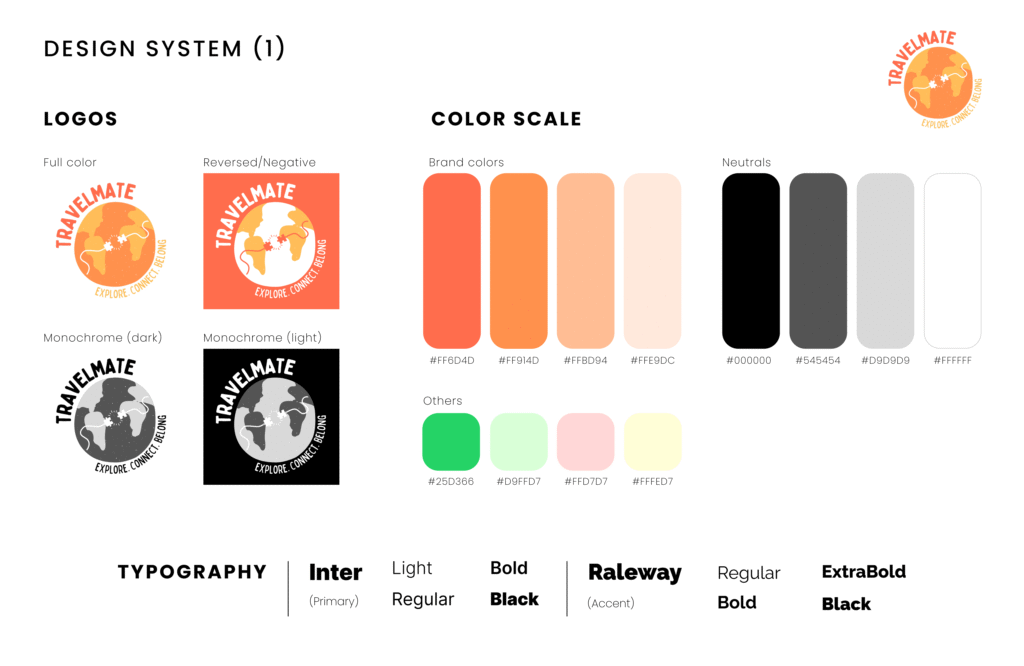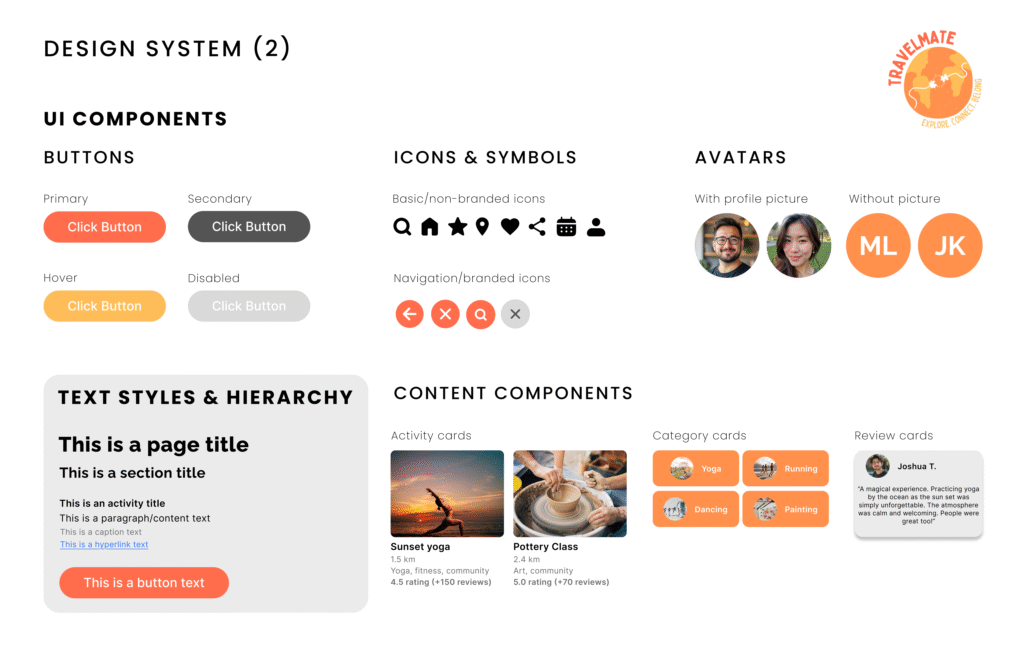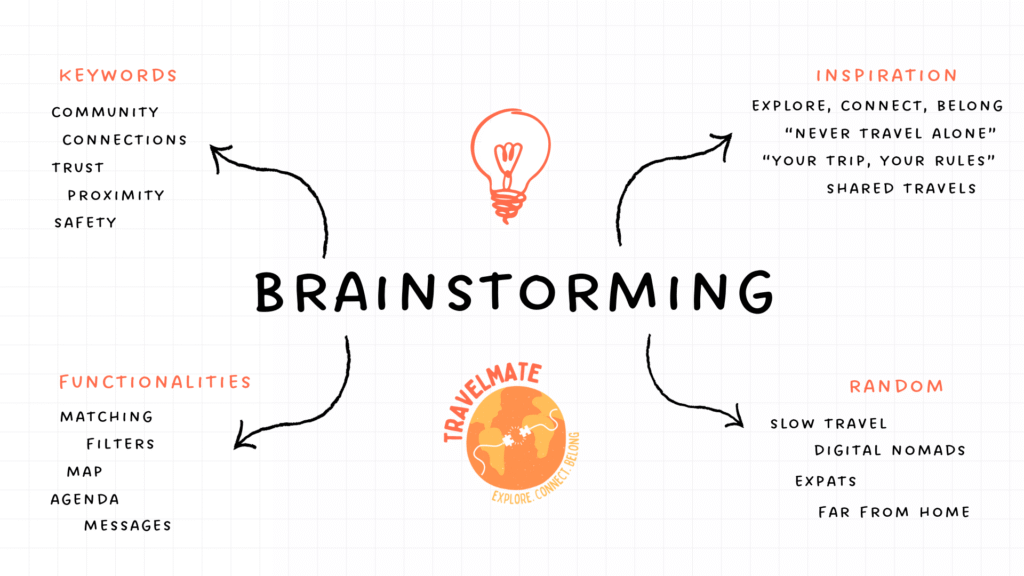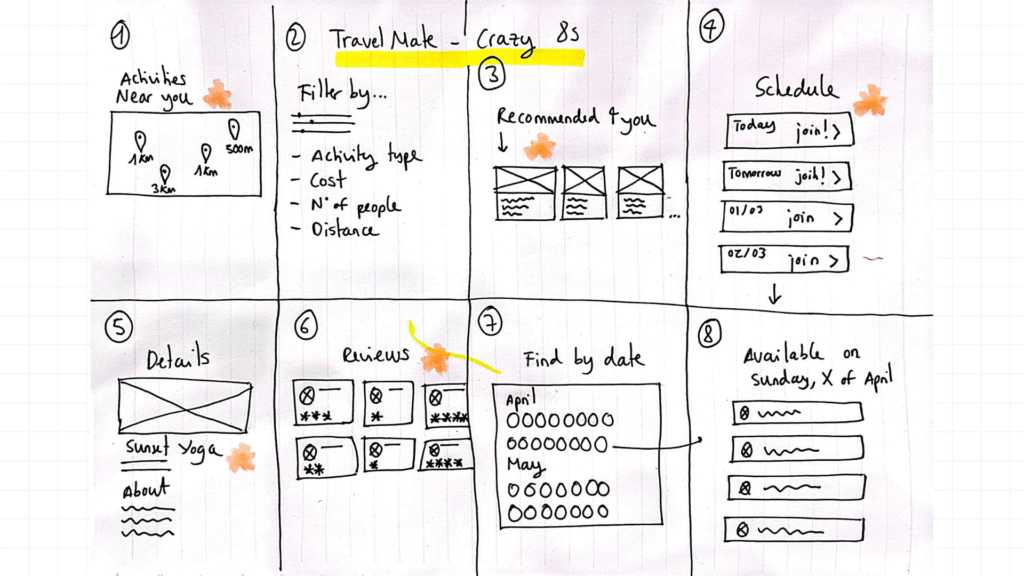To ensure visual consistency throughout the user experience, I developed a design system that brings together the key elements of TravelMate’s identity: color palette, typography, iconography, and reusable UI components. This system streamlined the creation of screens and guarantees that the application maintains a clear, cohesive, and scalable look.
EXPLORE.
CONNECT.
BELONG.
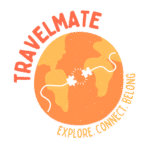

PROJECT OVERVIEW
TravelMate was created as an app for travelers who seek more than just visiting destinations: it’s about connecting with people, sharing experiences, and discovering activities in an authentic way. The project emerged from the need to make travel more social and meaningful, offering users a platform where they can join group activities with ease.
The goal was to design an intuitive and engaging experience that simplifies the search and booking of activities worldwide, all within a clear interface. TravelMate not only solves the challenge of finding quality plans in new destinations but also strengthens human connection, creating shared memories among travelers across the globe.
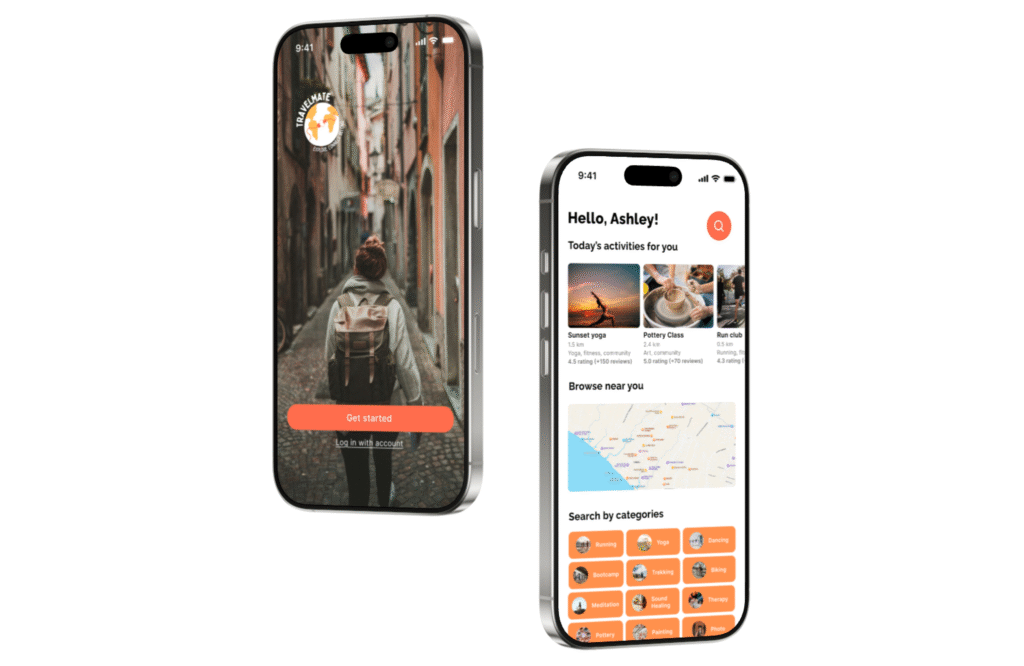
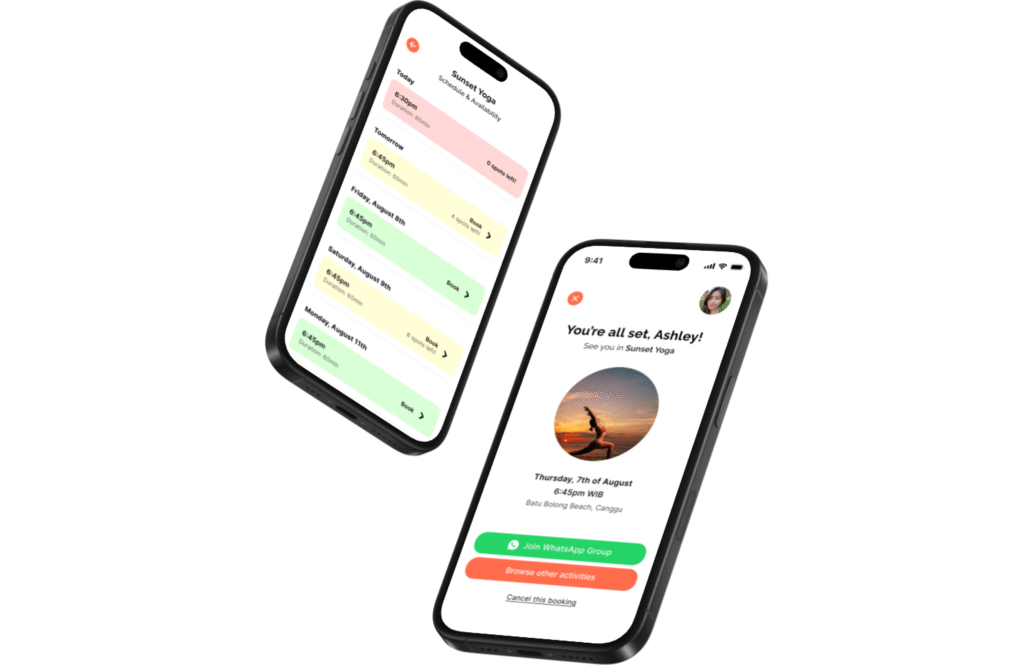
DURATION: 2 MONTHS | ROLE: UX/UI DESIGNER | METHODOLOGY: DESIGN THINKING | TOOLS: FIGMA, MIRO
DESIGN SYSTEM
DESIGN THINKING PROCESS
(1) EMPATHIZE · EXPLORING USER NEEDS
I explored travelers’ needs through interviews and surveys, aiming to understand their motivations and frustrations when on the move. The findings revealed two key insights:
The need to connect with like-minded people.
The difficulty of finding trustworthy group experiences.
USER PERSONA: LINDA WILSON
Linda is 28 years old, a Fine Arts graduate from Amsterdam, the Netherlands. She works fully remotely as a graphic designer, which allows her to travel while maintaining her job.
Goal: To find activities that help her connect with other travelers who share similar interests and become part of a community.
Pain Points: She misses having a single platform that centralizes the activities she wants to join (yoga, dance, and running).
(2) DEFINE · FRAMING THE PROBLEM
After understanding users’ needs and motivations, the next step was to synthesize these insights into a clear problem statement and a point-of-view statement that would guide the development of the solution.
😣 PROBLEM STATEMENT
People who travel alone often face challenges in finding activities and connecting with other travelers who share their interests. This can lead to frustration and a sense of isolation during their journeys.
😍 POV STATEMENT
TravelMate helps travelers discover activities by connecting them with others who share their interests, ensuring they never feel alone and can be part of a community at every destination.
(3) IDEATE · GENERATING CREATIVE SOLUTIONS
In the ideation phase, techniques such as brainstorming and Crazy 8s were used to generate and explore as many ideas as possible in a short amount of time. Brainstorming allowed for the collection of diverse concepts (keywords, features, etc.) on how to enhance the traveler experience, while Crazy 8s translated these ideas into quick sketches that helped visualize potential solutions for the development of the future app.
(4) PROTOTYPING · CREATING APP VERSIONS
In this phase, the selected ideas were transformed into tangible representations through wireframes and high-fidelity prototypes, in this case using Figma. The goal was to bring the solutions to life visually and interactively, allowing for rapid validation of usability, design, and system consistency before moving on to the testing phase.
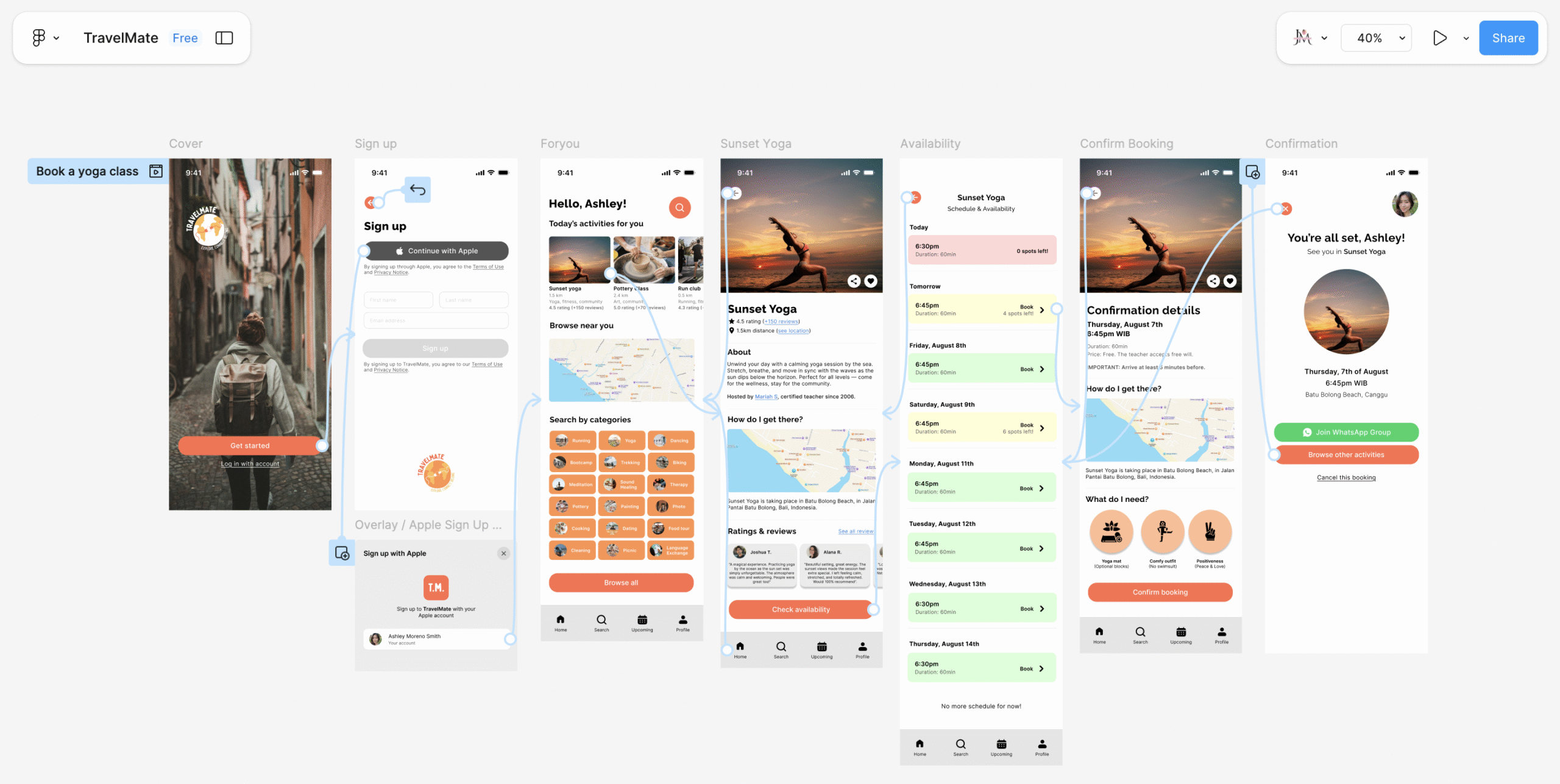
(5) TESTING · EVALUATING AND IMPROVING THE SOLUTION
In the testing phase, the prototype was evaluated with real users to identify improvements in the experience and to validate whether the proposed solutions effectively met their needs. This process helped uncover friction points, gather feedback, and refine the design before its final implementation.
👤 USER SELECTION
· 5 participants with diverse characteristics
· Users aligned with our target audience
🎯 TASKS TO EVALUATE
· Book the Sunset Yoga class within the prototype.
· Then, return to the home screen (For You page).
🔎 TOOLS USED
· Screen recordings and sessions via Google Meet.
· Google Forms for subsequent feedback collection.
✅ POSITIVE FEEDBACK
· Visual clarity
· Intuitive flow
· Confidence in booking
· Clear confirmation
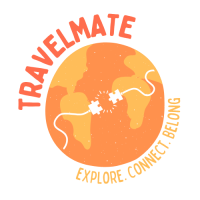
❌ FEEDBACK FOR IMPROVEMENT
· Button overload
· Initial registration process
· Too many categories
· Multiple confirmations
💡 IMPROVEMENTS FOR FUTURE ITERATIONS
· Enhance navigation clarity → add more visible labels so users understand where they are.
· Optimize the booking flow → reduce unnecessary steps in activity confirmation.
· Content personalization → include recommendations based on the traveler’s preferences and history.
· Visual feedback (microinteractions) → animations that improve the experience and make the app more intuitive.
FINAL CONCLUSIONS
The development of TravelMate allowed me to practically apply the Design Thinking methodology, transforming an idea into a functional prototype aimed at enhancing the traveler experience. Throughout the process, challenges arose, particularly in defining a clear booking flow and organizing information in an intuitive way. However, user testing provided significant value, highlighting both strengths (such as visual design and the community-focused value proposition) and areas for improvement related to usability and personalization.
This project underscores the importance of continuous iteration and listening to users in order to build more relevant and useful solutions. In future versions, incorporating personalized recommendations and further optimizing the interaction flow will be key to continuing the evolution of this project’s proposal.
